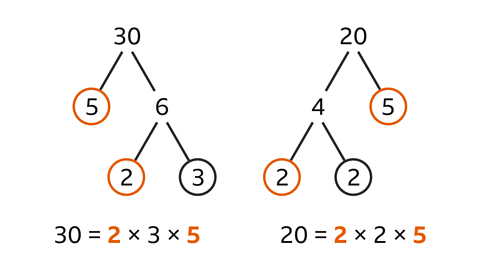Key points
A primeA whole number greater than 1 that has exactly two factors, itself and 1. Eg, 2 is a prime number (its factors are 2 and 1). 3 is a prime number (its factors are 3 and 1) number is a number that has exactly two factorA whole number that will divide into a selected number with no remainder. - itself and 1. There are an infinite number of prime numbers.
Numbers that have more than two factors are called composite numberA number that has more than two factors. . They can be expressed as a productThe result of multiplying one number by another, eg the product of 4 and 5 is 20 since 4 × 5 = 20 of prime numbers.
The number 1 is not a prime number or a composite number. It is often referred to as a unit.
The only even prime number is 2. All other even numbers can be divided by 2
Knowledge of prime numbers helps in understanding of highest common factor (HCF), lowest common multiple (LCM) and product of prime factors.
Knowledge of prime numbers is helpful in supporting understanding of highest common factor (HCF) The largest factor that will divide into the selected numbers. Eg, 10 is the highest common factor of 30 and 20. Highest common factor is written as HCF. (HCF), lowest common multiple (LCM)The lowest multiple that is common to two or more numbers. The LCM of 15 and 12 is 60 because it is the lowest value in both of their multiplication tables. Also known as the least common multiple. and product of prime factorsThe factors of 12 are 1, 2, 3, 4, 6 and 12. The prime factors of 12 are 2 and 3. 12 may be expressed as a product of its prime factors: 12 = 2 × 2 × 3 .
Prime numbers activity
Play this game to find all the prime numbers up to 100.
What is a prime number?
- A prime number has exactly two factorA whole number that will divide into a selected number with no remainder. – itself and 1. This means it also only has one factor pairTwo numbers that, when multiplied together, make a selected whole number. Eg, 3 and 4 are multiplied together to make 12 so 3 and 4 are a factor pair of 12. A whole number may have one or more factor pairs..
- A prime number is only divisible by itself and 1
Prime numbers are used to:
- find the highest common factor (HCF) The largest factor that will divide into the selected numbers. Eg, 10 is the highest common factor of 30 and 20. Highest common factor is written as HCF. (HCF) and lowest common multiple (LCM)The lowest multiple that is common to two or more numbers. The LCM of 15 and 12 is 60 because it is the lowest value in both of their multiplication tables. Also known as the least common multiple. of two or more numbers.
- break down a composite numberA number that has more than two factors. into a product of its prime factors.
Examples
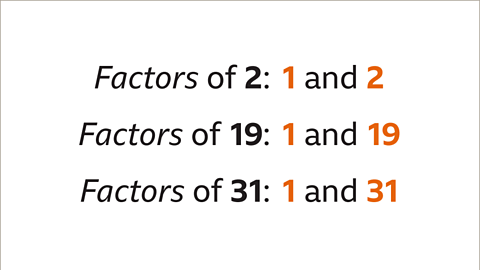
Image caption, Every prime number has exactly two factors – 1 and itself. This is one factor pair. 2, 19 and 31 are prime numbers. The factors of 2 are 1 and itself (2). The factors of 19 are 1 and itself (19). The factors of 31 are 1 and itself (31)
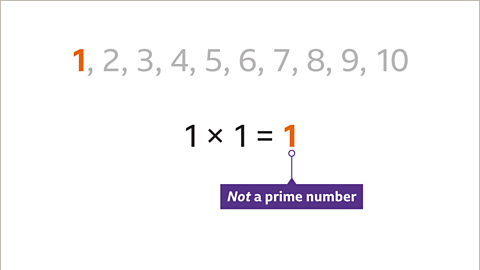
Image caption, 1 is not a prime number. It only has one factor (1)
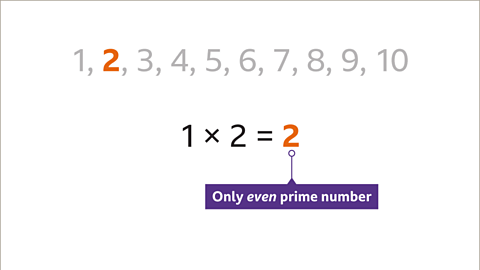
Image caption, 2 is the only even prime number. 2 has two factors - itself and 1
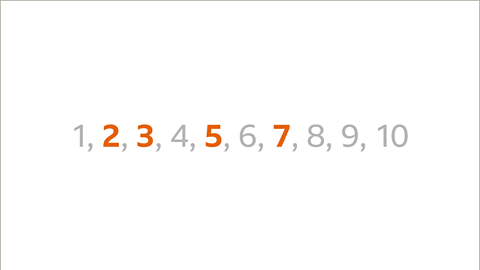
Image caption, 1 is not a prime number because it has exactly one factor (1). 2, 3, 5 and 7 are prime numbers. They each have two factors (1 and themselves). 4, 6, 8, 9 and 10 are not prime numbers because they each have more than two factors.
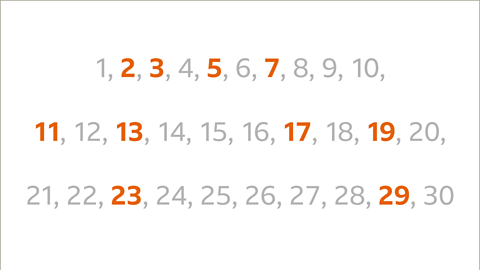
Image caption, The prime numbers up to 30 are 2, 3, 5, 7, 11, 13, 17, 19, 23, and 29. There are an infinite number of prime numbers.
1 of 5
Question
Which numbers between 80 and 90 are prime numbers?
80, 81, 82, 83, 84, 85, 86, 87, 88, 89, 90

The only prime numbers between 80 and 90 are 83 and 89
83 = 1 x 83
89 = 1 x 89
All the other numbers have more than two factors.
A prime number has exactly two factors, itself and 1
Practise prime numbers
Practise what you've learned about prime numbers with this quiz.
Quiz
Real-world maths

Prime numbers are important in creating digital security systems (cybersecurity).
The prime numbers used to secure data through encryption are extremely large. You can multiply two very large prime numbers together, but it is difficult to break that number back down and find the factors.
This is part of what keeps information secure.

Video
Keeping online information secure is very important for businesses.
Watch the video to listen to Kim, a textile designer, discuss how prime numbers help her when selling silk scarves online to her customers.
Bobby: Do you know about prime numbers, those unique numbers that only have two different factors?
(MUSIC)
Bobby: So, where do you sell these silk scarves?
Kim: We sell them in markets, shops, but mainly online shops.
Bobby: Ah, so when you sell online, do your customers buy directly from your website?
Kim: Yeah, they do.
Bobby: OK, so for you, is online security really important for you and your customers?
Kim: Absolutely, that’s where all the transactions happen between us, and that’s where we make our money.
Bobby: OK, so actually, did you know to keep your data safe and secure, it's all encrypted using prime numbers?
Kim: Oh, OK.
Bobby: What it does, to create a secure code, you need two prime numbers, you multiply them together and that gives you a third number, and this is your encryption code.
So, imagine your encryption code was the number 15. Can you think of two prime numbers that multiply to make 15?
Kim: Ah, so that would be 5 and 3?
Bobby: Perfect, so you solved the code, as it were. But for computers, what they use is, in the real world, they will pick two really large prime numbers with, say, 20 digits and maybe 30 digits and multiply them together. And now your third number, your encryption code, is this new large number.
Kim: Yeah, wow. That would be like a super long number!
Bobby: Yeah, and that's very difficult to work out. So actually, for you and your customers, to keep your data safe and secure, they rely on prime numbers.
Game - Divided Islands
Play the Divided Islands game! gamePlay the Divided Islands game!
Using your maths skills, help to build bridges and bring light back to the islands in this free game from BBC Bitesize.

More on Prime numbers, factors and multiples
Find out more by working through a topic
- count1 of 4
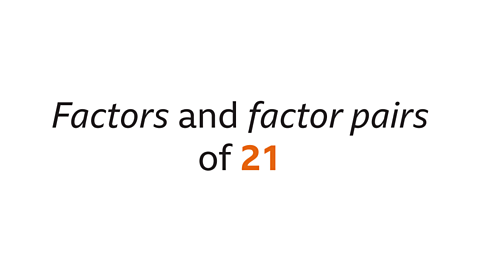
- count2 of 4

- count3 of 4
